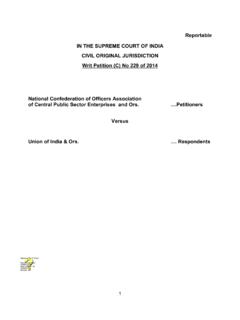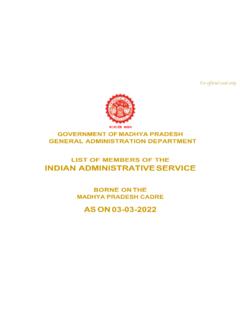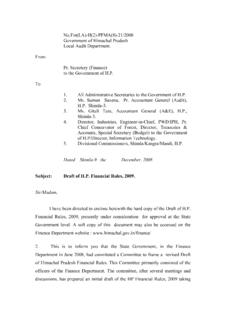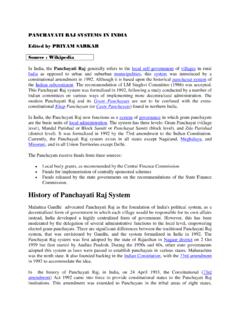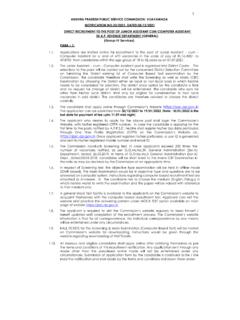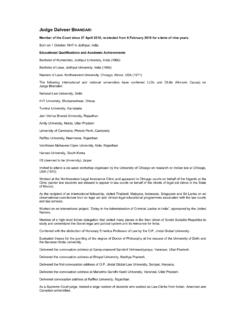Transcription of SUO MOTU CONTEMPT PETITION (CRL.) NO.1 OF 2020 IN RE ...
1 REPORTABLE IN THE SUPREME COURT OF INDIAINHERENT JURISDICTIONSUO MOTU CONTEMPT PETITION (CRL.) OF 2020IN RE: PRASHANT BHUSHAN AND U D G M E N Shri Venugopal, learned Attorney general for India, Dhavan, Shri Dushyant Dave, Shri Singh, learned seniorcounsel, and the contemnor Shri Prashant having adjudged Shri Prashant Bhushan, Advocate, guilty ofcontempt vide judgment dated , Dr. Rajeev Dhavan and ShriDushyant Dave, learned senior counsel appearing for the contemnor ShriPrashant Bhushan raised the following arguments: (i) That the copy of the PETITION on the basis of which the suo motucognizance was taken by this Court with respect to first tweet, filed byShri Mahek Maheshwari, was not furnished, in spite of the applicationhaving been filed by the contemnor.
2 Thus, it could not be ascertainedwhether the complaint was mala fide or even personally or (ii)The factors relevant for sentencing are the offender, the offence, theconvicting judgment, statutory or other defences relating to a substantialinterference with justice, truth, bona fides, and public interest indisclosure.(iii)The contemnor is a lawyer of 35 years of standing, who haspursued public interest litigation successfully at some personal andprofessional cost. He got appreciation from the Court. He is a foundingmember of Campaign for Judicial Accountability, which includes severalsenior counsel of repute.
3 He has brought certain corruption cases andcauses to the Court such as V. Ramaswamy case, Coal Mining case, GoaMining case, Orissa Mining case, an issue relating to the appointment ofCVC, CBI Director s case, Lok Pal case etc. In the public interest, he hasfiled several petitions like Narmada case, Bofors case, Police Reform case,Passive Euthanasia case, HPCL Privatization case, Street Vendors case,Rickshaw Pullers case, Singur Land Acquisition case, DraughtManagement, Gram Nyayalaya, and Electoral Bond cases.(iv) The nature of offences is another ingredient to be taken intoconsideration while imposing sentence; (i) Offence must be clear withoutambiguity.
4 (ii) The potential offender must know/understand whetherhe/she is guilty of the offence. The offence of scandalizing the Court isnotoriously vague. It has not been defined by the Statute. It is called2"vague and wandering jurisdiction. Reliance has been placed onShreya Singhal v. Union of India, 2015 (5) SCC 1. Such an offencehas to be handled with care and used sparingly, as observed inBaradakanta Mishra v. Registrar of Orissa High Court & another,(1974) 1 SCC 374. There is inconsistency in various decisions relating tothe conviction and sentence due to vagueness.
5 (v)The very jurisdiction of CONTEMPT is scandalizing and is vague andcolonial. Several decisions have been relied upon where the Court hasnot even initiated CONTEMPT in such matters. In some of the countries,the CONTEMPT law being an archaic law has already been done away cannot be any compromise with the Right to Free Speech andOpinions. (vi)In the convicting judgment, reliance was placed on the decisions Duda v. P. Shiv Shanker & Others, (1988) 3 SCC 167), BrahmaPrakash Sharma and Others v. The State of Uttar pradesh , 1953 SCR1169, and In Re: Hira Lal Dixit and two others, (1955) 1 SCR decision in Sankaran Namboodripad v.
6 T. NarayananNambiar, (1970) 2 SCC 325, has been superseded by Duda (supra).In so far as the decision in Sankaran Namboodripad (supra) isconcerned, the same would not be relevant inasmuch as the same stands3overruled by Duda (supra). Similarly, reliance on the judgment inC. K. Daphtary & Ors. v. O. P. Gupta & Ors., (1971) 1 SCC 626, is alsonot relevant inasmuch as the said judgment is delivered prior toamendment of CONTEMPT of Courts Act, 1971 (for short the Act ), videwhich Section 13(b) was brought on statute book, so as to allow truth asa defence. The Court has to exercise jurisdiction with great care andcaution and only in cases that are clear beyond reasonable doubt.
7 InRe: S. Mulgaokar, (1978) 3 SCC 339, various guidelines have been laiddown by this Court. They are, free market of ideas, fair criticism in goodfaith when it is in the public interest, the surrounding circumstances,the person who is making the comments, his knowledge in the fieldregarding which the comments are made and the intended considering all these guidelines, an advocate should be punished byexercising extreme caution only in the case where the tendency is tocreate disaffection and disrepute to erode the judicial system. Thoughthe convicting judgment, on the one hand cites various decision onbalance, on the contrary holds the contemnor guilty for the fair criticismmade by him.
8 (vii) There is no conflict between the constitutional jurisdiction underArticles 129, 215 of the Constitution of India, and the CONTEMPT ofCourts Act. In Pallav Sheth v. Custodian & Ors., (2001) 7 SCC 549, it4was laid down that the powers of punishment for CONTEMPT under Article129 of the Constitution of India have to be exercised in consonance withthe CONTEMPT of Courts Act, 1971.(viii)Besides that, provisions in Sections 8 and 9 and newly amendedSection 13(a) of the Act requires that the Court cannot impose a sentenceunless it is satisfied that CONTEMPT is of such a nature that substantiallyinterferes or tends substantially to interfere with the due course ofjustice.
9 Thus, special responsibility is cast on the Court to examine theextent of interference. The provisions of newly amended Section 13(a)amply make it clear that the Court is required to assess the situationitself. However, in the convicting judgment no such inquiry has takenplace and as such an order of sentence cannot be passed. Truth shouldordinarily be allowed as a defence unless the Court finds, that it is only acamouflage to escape the consequences of the deliberate attempt ofscandalizing the Court. Section 13 of the Act enables the Court to permitjustification by truth as a valid defence in any CONTEMPT proceedings if itsatisfied that such a defence is in the public interest and the request forinvoking the defence is bona fide.
10 Reliance is placed on SubramanianSwamy v. Arun Shourie, (2014) 12 SCC 344. In so far as the firsttweet is concerned, the tweet is an expression of opinion by ShriPrashant Bhushan that due to the Courts not functioning physically the5litigants are deprived of real access to justice. It is submitted that thisopinion also finds support from the observations made by this court InRe: Financial aid for members of Bar affected by a pandemic (In SuoMoto Writ PETITION ) that due to the suspension of physicalfunctioning of the Courts, the lawyers have been deprived of sources ofearning their livelihood.
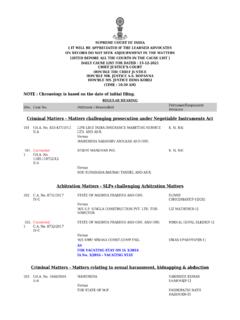
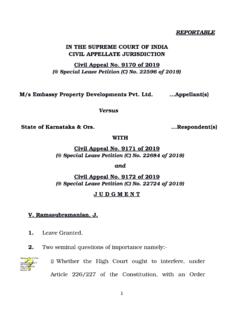
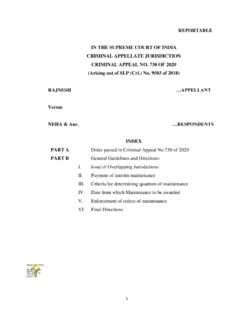
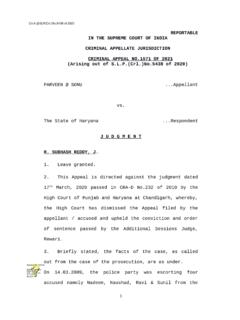
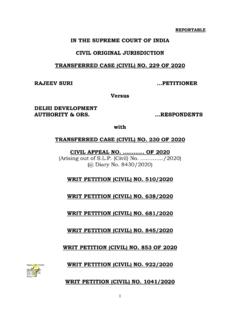
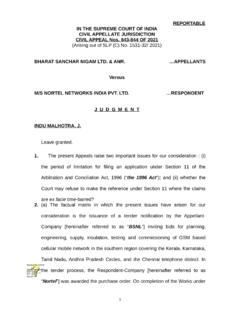
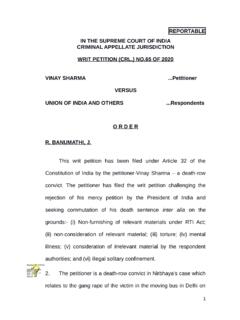
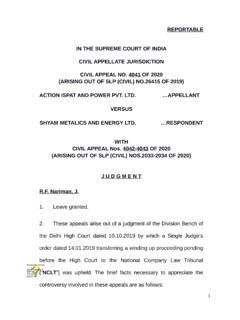
![[DEFAULT / OTHER MATTERS] [SERVICE/COMPLIANCE] …](/cache/preview/4/8/a/c/d/7/0/e/thumb-48acd70e206083f8f3d37421a64ec859.jpg)
